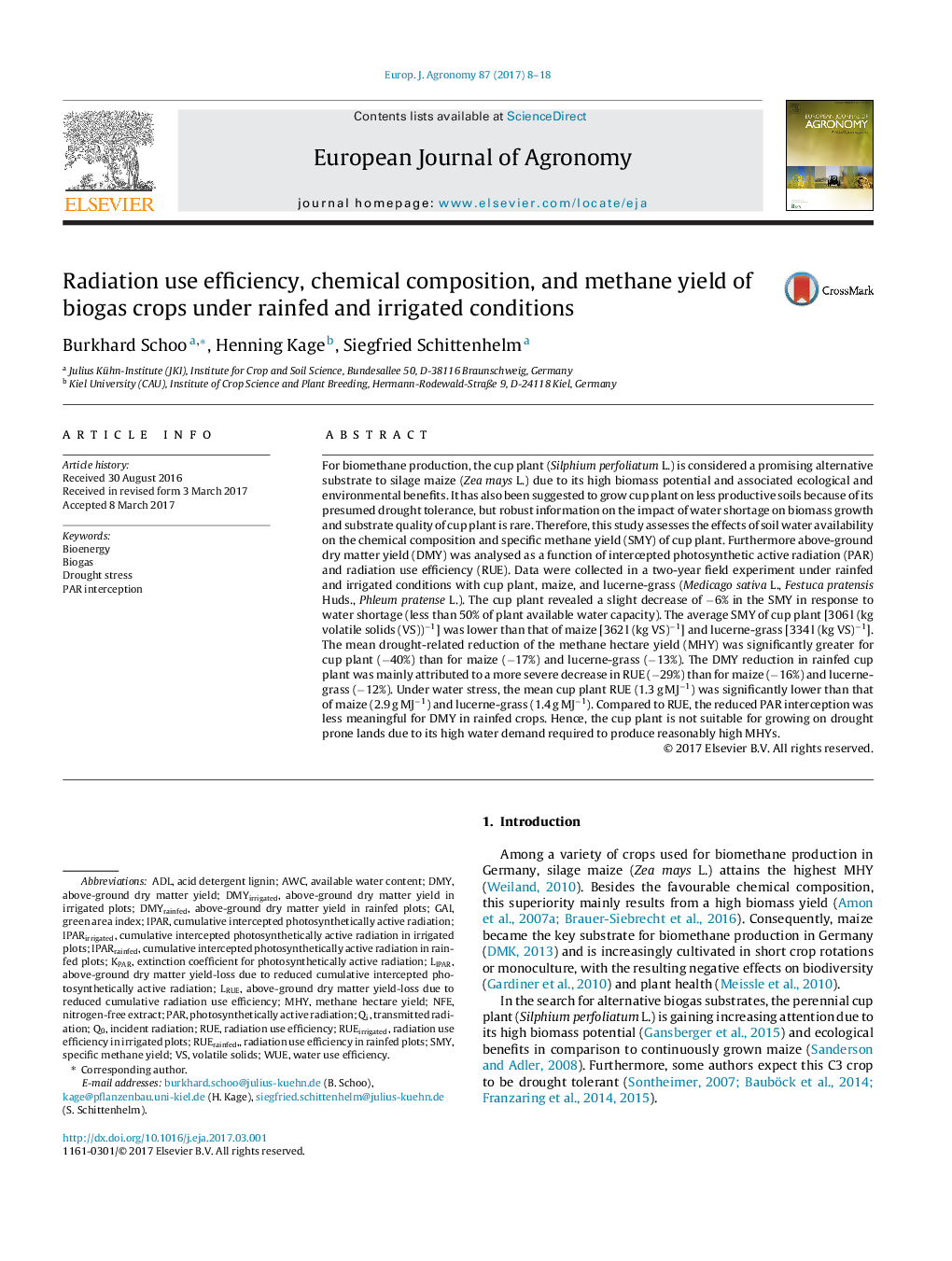| کد مقاله | کد نشریه | سال انتشار | مقاله انگلیسی | نسخه تمام متن |
|---|---|---|---|---|
| 5761207 | 1624437 | 2017 | 11 صفحه PDF | دانلود رایگان |
عنوان انگلیسی مقاله ISI
Radiation use efficiency, chemical composition, and methane yield of biogas crops under rainfed and irrigated conditions
ترجمه فارسی عنوان
بازده استفاده رادیاتور، ترکیب شیمیایی و عملکرد متان محصولات بیوگاز تحت شرایط بارندگی و آبیاری
دانلود مقاله + سفارش ترجمه
دانلود مقاله ISI انگلیسی
رایگان برای ایرانیان
کلمات کلیدی
PAR interceptionnitrogen-free extractIncident radiationWUEGAINFEADLSMYDMYAWCWater use efficiency - بهره وری استفاده از آبRadiation use efficiency - بهره وری استفاده از تابشBiogas - بیوگازPhotosynthetically active radiation - تابش فعال فتوسنتزیDrought stress - تنش خشکیPar - توسطvolatile solids - جامدات فرارRUE - روپیهBioenergy - زیستانرژیGreen Area Index - شاخص منطقه سبزIPAR - صنعتSpecific methane yield - عملکرد متان خاصacid detergent lignin - لیگنین پاک کننده اسیدAvailable water content - محتوای آب موجود
موضوعات مرتبط
علوم زیستی و بیوفناوری
علوم کشاورزی و بیولوژیک
علوم زراعت و اصلاح نباتات
چکیده انگلیسی
For biomethane production, the cup plant (Silphium perfoliatum L.) is considered a promising alternative substrate to silage maize (Zea mays L.) due to its high biomass potential and associated ecological and environmental benefits. It has also been suggested to grow cup plant on less productive soils because of its presumed drought tolerance, but robust information on the impact of water shortage on biomass growth and substrate quality of cup plant is rare. Therefore, this study assesses the effects of soil water availability on the chemical composition and specific methane yield (SMY) of cup plant. Furthermore above-ground dry matter yield (DMY) was analysed as a function of intercepted photosynthetic active radiation (PAR) and radiation use efficiency (RUE). Data were collected in a two-year field experiment under rainfed and irrigated conditions with cup plant, maize, and lucerne-grass (Medicago sativa L., Festuca pratensis Huds., Phleum pratense L.). The cup plant revealed a slight decrease of â6% in the SMY in response to water shortage (less than 50% of plant available water capacity). The average SMY of cup plant [306 l (kg volatile solids (VS))â1] was lower than that of maize [362 l (kg VS)â1] and lucerne-grass [334 l (kg VS)â1]. The mean drought-related reduction of the methane hectare yield (MHY) was significantly greater for cup plant (â40%) than for maize (â17%) and lucerne-grass (â13%). The DMY reduction in rainfed cup plant was mainly attributed to a more severe decrease in RUE (â29%) than for maize (â16%) and lucerne-grass (â12%). Under water stress, the mean cup plant RUE (1.3 g MJâ1) was significantly lower than that of maize (2.9 g MJâ1) and lucerne-grass (1.4 g MJâ1). Compared to RUE, the reduced PAR interception was less meaningful for DMY in rainfed crops. Hence, the cup plant is not suitable for growing on drought prone lands due to its high water demand required to produce reasonably high MHYs.
ناشر
Database: Elsevier - ScienceDirect (ساینس دایرکت)
Journal: European Journal of Agronomy - Volume 87, July 2017, Pages 8-18
Journal: European Journal of Agronomy - Volume 87, July 2017, Pages 8-18
نویسندگان
Burkhard Schoo, Henning Kage, Siegfried Schittenhelm,
